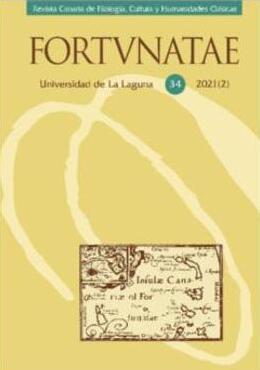Ἀβλαβὲς ὕδωρ y ἀάατον Στυγὸς ὕδωρ
Resumen
EnTeócrito, idilio XXIV, 98 ἀβλαβὲς ὕδωρ el adjetivo mantiene el sentido homérico de βλάπτω, βλάβομαι, ‘interrumpir el movimiento de algo que corre’, y evoca al mismo tiempo la frase ἀάατον Στυγὸς ὕδωρ de Ilíada XIV, 271, porque en la antigua exégesis ἀβλαβής era una explicación habitual de la difícil palabra ἀάατος.
Citas
BARBER, P. (1988): Vampires, Burial, and Death: Folklore and Reality, New Haven. CGL = The Cambridge Greek Lexicon, Cambridge, 2021.
CHANTRAINE, P. (2009): Dictionaire étymologique de la langue grcque. Histoire des mots, nouvelle edition, Paris.
CHADWICK, J. (1996): Lexicographia Graeca: Contributions toThe Lexicography of Ancient Greek, Oxford.
CUYPERS, M. P. (2003): «Apollonians anonymous: ἀάατος, ἄατος, and ἄμοτον in Argonautica 2.77-78», en D. ACCORINTI - P. CHUVIN (eds.), Des Géants à Dionysos. Mélanges de mythologie et de poésie grecques offerts à Francis Vian, Alessandria, pp. 223-232.
DGE = Diccionario griego-español, Madrid, 1980-.
DICKEY, E. (2007): Ancient Greek Scholarship: a guide to finding, reading, and understanding scholia, commentaries, lexica, and grammatical treatises, from their beginnings to the Byzantine period, London and New York.
DINDORF, W. (1855): Scholia Greaca in Homeri Odysseam, Oxonii. EM = Enzyklopädie des Märchens. Handwörterbuch zur historischen und vergleichenden Erzählforschung, 14 vols., Berlin, 1975-2014.
ERBSE, H. (1969-1988): Scholia Graeca in Homeri Iliadem (Scholia Vetera), 7 vols., Berlin.
FREUD, S. (1922): «Traum und Telepathie», Imago 8: 1-22.
GARCÍA TEIJEIRO, M. (1985): «Escatología griega e Islas de los Bienaventurados», en Serta Gratulatoria in honorem Juan Régulo, I, La Laguna, pp. 271-280.
GARCÍA TEIJEIRO, M. (1991): «ἀβλαβὲς ὕδωρ», Fortunatae 1: 11-18.
HIRZEL, R. (1902): Der Eid. Ein Beitrag zu seiner Geschichte, Leipzig.
HWDA = Handwörterbuch des deutschen Aberglaubens, 10 vols., Berlin - Leipzig, 1927-1942. LfgrE = Lexikon des frühgriechischen Epos, Göttingen, 1955-2010.
LSJ = H. G. LIDDELL y R. SCOTT (1996): A Greek-English Lexicon, 9ª. ed., Oxford.
LÓPEZ EIRE, A. -VELASCO LÓPEZ, Mª. H. (2012): La mitología griega: Lenguaje de hombresy dioses, Madrid.
LUQUE MORENO, J. (2007a): «‘Agua de Éstige’, agua del horror», FlorIlib 18: 251-309.
LUQUE MORENO, J. (2007b): «Styx y Stygius como designaciones del infierno y de lo infernal», CFC(L) 27: 11-50.
MOORHOUSE, A. C. (1961): «ἈΑΑΤΟΣ and Some Other Negative Compounds», CQ: 11: 10-17.
NAGY, G. (1997: «Homeric Scholia», en I. MORRIS & B. POWELL (eds.), A New Companion to Homer, Leiden, pp. 101-122.
NIKOLAEV, A. (2012-2013): «Homeric ἀάατος: Etymology and Poetics», Die Sprache, 50: 182-239.
PGM = K. PREISENDANZ (1973-1974): Papyri Graecae Magicae, 2ª. ed. rev. por A. Henrichs, 2 vols., Stuttgart.
RADERMACHER, L. (1903): Das Jenseits im Mythos der Hellenen: Untersuchungen über Antiken Jenseitsglauben, Bonn.
RENGAKOS, A. (1994): Apollonios Rhodios und die antike Homererklarung, München.
SCHULZE, W. (1892): Quaestiones epicae, Gueterslohae.
STEKEL, W. (1911): Die Sprache des Traumes: eine Darstellung der Symbolik und Deutung des Traumes in ihren Beziehungen zur kranken und gesunden Seele für Ärzte und Psychologen, Wiesbaden.
THOMPSON, S. (1955-19582): Motif-Index of Folk Literature, 6 vols., Bloomington.
TOMBERG, K.-H. (1968): Die Kaine Historia des Ptolemaios Chennos. Eine literarhistorische und quellenkritische Untersuchung, Bonn.
VAN BEEK, L. C. (2017): «Die Bildersprache des Rechts im Indogermanischen. Griechisch ἰθεῖα δίκη und δίκην βλάπτειν», en H. BICHLMEIER and A. OPFERMANN (eds.), Das Menschenbild bei den Indogermanen, Hamburg, pp. 129-150.
VAN THIEL, H. (2014.): Scholia D in Iliadem: Proecdosis Aucta et Correctior. Secundum codices manuscriptos (Elektronische Schriftenreihe der Universitäts- und Stadtbibliothek, Band 7), Köln.
VELASCO LÓPEZ, Mª. H. (2001): El paisaje del más allá: El tema del prado verde en la escatología indoeuropea, Valladolid.
WEST, M. L. (2007): Indo-European Poetry and Myth, Oxford.
Los autores conservan los derechos de autor y garantizan a la revista el derecho de ser la primera publicación del trabajo al igual que licenciarlo bajo una Creative Commons Attribution License que permite a otros compartir el trabajo con un reconocimiento de la autoría del trabajo y la publicación inicial en esta revista.
Los autores pueden establecer por separado acuerdos adicionales para la distribución no exclusiva de la versión de la obra publicada en la revista (por ejemplo, situarlo en un repositorio institucional o publicarlo en un libro), con un reconocimiento de su publicación inicial en esta revista.





